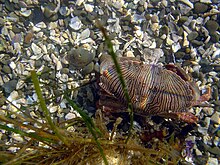Cancer productus
| Cancer productus | ||||||||||||
|---|---|---|---|---|---|---|---|---|---|---|---|---|

Cancer productus |
||||||||||||
| Systematics | ||||||||||||
|
||||||||||||
| Scientific name | ||||||||||||
| Cancer productus | ||||||||||||
| Randall , 1840 |
Cancer productus is a crab from the family of crabs . It is widespread on the Pacific coast of North America, where it is called “Red rock crab” because of its red color.
features

Characteristic of Cancer productus are the five approximately equal teeth between the eyes, in comparison to the other Cancer pass TYPES forward and well ahead of the eye sockets of the carapace are. The type epithet “productus”, which means “extended” or “advanced”, is derived from this characteristic . The distance between the eye sockets corresponds to about a fifth of the total carapace width.
On each side of the eyes there are 10 teeth, which become larger and more pointed towards the back. As with all edible crabs, the carapace is wider than it is long. It can be up to 20 cm wide in males and up to 17 cm wide in females. The surface of the carapace is rather smooth and without tubercles or clear elevations, but overall uneven. Its color is brick red, in juveniles it is initially whitish and becomes white-red stripes as it grows.
The dactylus of the first stride leg , the movable scissor finger, is black at its tip. This distinguishes Cancer productus from the similar type Cancer magister . The prodopus of the first stride leg has tubercles lined up in a longitudinal direction.
distribution and habitat
Cancer productus is widespread on the Pacific coast of North America, from the Kodiak Archipelago in the north, to Laguna Beach , or to San Diego in California in the south. The populated sea depth extends from the shore zone to a maximum of 90 m. The habitats can be rocky or sandy. Cancer productus usually hangs out on rocks and hides during the day, either under rocks or buried in the sand.
The oldest fossils of Cancer productus come from the Middle Pliocene .
ecology
Cancer productus is carnivorous . The prey animals include mussels , small crustaceans , barnacles , amphipods , sea cucumbers and many other invertebrates and dead fish that occur on the coasts . The mussels that are eaten include a. Leukoma staminea , Nuttalia obscurata , Venerupis philippinarum , Mytilus californianus and oysters .
Especially Juvenile prey are of bullheads , Paralabrax clathratus or Morone chrysops . Also from the Pacific giant octopus is Cancer productus prey.
Mating occurs in summer shortly after the female has molt. Even before moulting, the male carries the female with him below his abdomen. Even after moulting and mating, it carries and protects the female until the shell is completely hardened. The number of eggs can be up to 600,000.
Typical epibionts of Cancer productus are not only algae but also barnacles, especially Balanus crenatus .
Individual evidence
- ↑ a b c d e f g h i j Dave Cowles: Cancer productus. (No longer available online.) Walla Walla University, 2005, archived from the original on March 24, 2012 ; Retrieved July 19, 2013 . Info: The archive link was inserted automatically and has not yet been checked. Please check the original and archive link according to the instructions and then remove this notice.
- ↑ a b c d e f J.D. Nations: The genus Cancer (Crustacea: Bachyura): systematics, biogeography, and fossil record . In: Natural History Museum of Los Angeles County Science Bulletin . tape 23 , 1975, p. 1–104 ( PDF, 10MB [accessed July 19, 2013]).
- ↑ EB Hartwick, L. Tulloch, S. MacDonald: Feeding and growth of Octopus dofleini . In: The Veliger 24 (2), 1981, pp. 129-138.